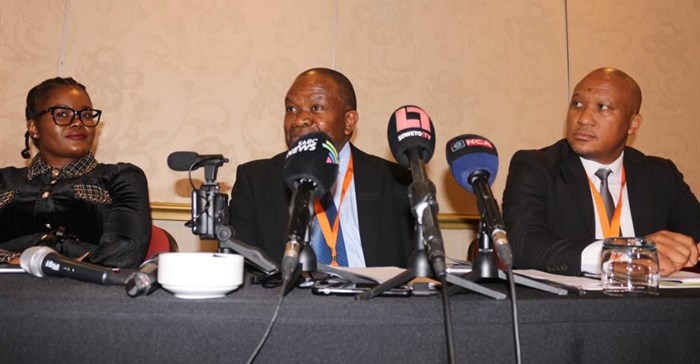
Sanedi CEO, Dr Titus Mathe, highlighted the need for an “and-and” approach rather than an “either-or” approach. He clarified that repowering and repurposing old power stations would not be limited to a single technology but would explore a variety of cleaner fossil-fuel technologies.
The same theme was echoed in responses to questions about the use of international loans and grants to fund South Africa’s Just Energy Transition (JET), and the implementation of renewable energy sources in rural areas and informal settlements. Panellists emphasised that South Africa’s Integrated Resource Plan (IRP) provides the policy framework for funding applications and technology exploration, and that a broad range of options are being considered within this framework.
“We welcome the loans announced by National Treasury today,” said Mathe, “but it is important to understand that the funding comes to us in response to the government’s policy framework.”
The Deputy Minister of Mineral Resources and Energy, Nobuhle Nkabane, mentioned that the presidential planning commission that deals with all matters related to climate change is formulating the plan according to which the R33.5bn in new loans will be allocated.
Mathe noted that Sanedi’s view is that the funds will be used to upgrade the grid, roll out cleaner coal technologies and do research.
Grid requirements arose as a reason for the delay in finalising and publishing the long-awaited updated IRP. In response to several questions regarding the IRP, the panellists noted that the 2019 plan had not taken transmission requirements into consideration. Adding a transmission module to the modelling, as well as green hydrogen as a fuel of the future, had delayed the plan.
However, it is going through cabinet now and should be ready for public participation by the end of this year.
Sanedi highlighted the range of technologies that have been successfully piloted and are ready to be rolled out in rural areas and informal settlements. These include paint that cool down roofs and walls, biogas, solar technology, and biofuels.
Prof Sampson Mamphweli mentioned the innovative work being done to convert captured carbon into useful products such as green ammonia. He also highlighted the multi-stakeholder project currently being piloted in a village in Limpopo that combines water, food and energy technologies with rural economic and skills development, as well as technology-driven solutions – such as solar-powered science and media labs – to improve rural education.
While JET is well-known now, Dr Mathe introduced the Balanced Just Energy Transition in his welcoming address.
When asked to unpack it, he said that “balanced” signifies that all technologies must be considered in the country’s energy transition programme. Casting the net as wide as possible not only to technology, but also to participants in the process.
There is a role for the private sector to play in research and development, in supporting Eskom to overcome the electricity crisis and even in building new generating capacity.
Nkabane summarised it best with her concluding statement when she reiterated the International Energy Agency’s recent declaration that oil, gas and nuclear are regarded as green technologies that should be exploited to grow economies.
“We have to develop our own reserves within the context of our national climate-change mitigation commitments and the socioeconomic circumstances of our people," he said. "We need to invest in science, technology and innovation to grow the economy and address our energy challenges.”